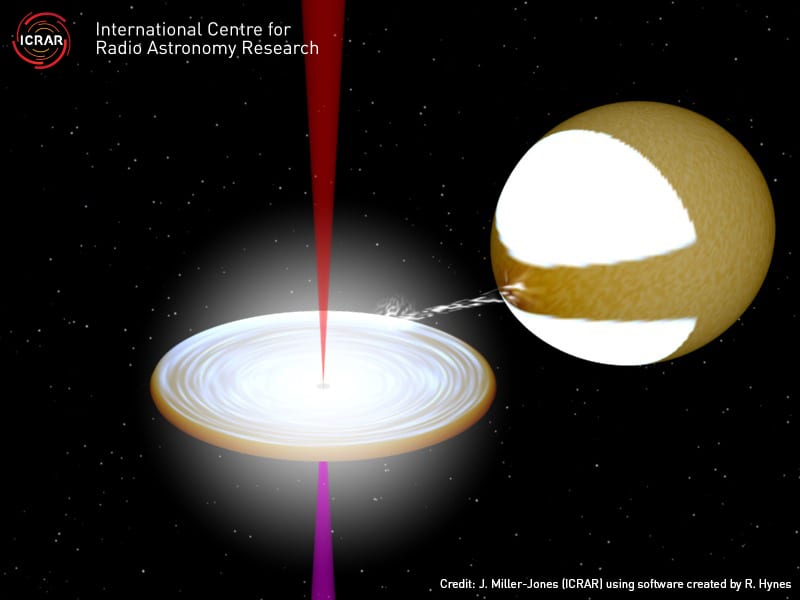Dr James Miller-Jones has been busy. Not only did he just get his team’s latest mystery solving research published in the journal Nature but he has also just been awarded WA’s Young Tall Poppy Award for 2013.
The Tall Poppy Awards are awarded each year by the Australian Institute of Policy and Science to scientists in each state who are undertaking significant research and are committed to communicating their work to a larger audience. Dr Miller-Jones was awarded for his recent work on black holes and the jets that form around them.
“They are very simple,” said Dr Miller-Jones.
“They have a mass, a charge and they spin. But they are the densest objects that we know of and light cannot escape.”

A model of the black hole system with the jets that have been found to contain atomic matter. Credit: J. Miller-Jones (ICRAR) using software created by R. Hynes.
Black holes cannot be seen as light falls into them but their effect on the space around them can be observed. It takes the form of a disk of matter and occasionally some of the matter is ejected in high speed jets. For decades, astronomers have wondered whether the jets consisted of positrons or positively charged atoms.
“Until now, we weren’t sure what they are made of, or what powers them,” said Dr Maria Diaz Trigo, from the European Southern Observatory, who was lead author on the study published in Nature.
Dr Miller-Jones led the radio side of an international team’s project to study the jets from smaller black holes – those that were only few times the size of the Sun – and on their second observation they picked up X-rays that suggested the matter was made of ordinary atoms of nickel and iron being propelled at high speeds.
Nickel and iron are heavier than positrons and require more energy to move as fast and as far as the jets do, meaning the jets are far more powerful than astronomers previously thought. The X-ray data suggested that the speed of the jets was 198,000 km/sec, or two-thirds the speed of light. It’s the closest and most accurate measurement of a jet’s speed yet.
Five other WA scientists were given Tall Poppy Awards in 2013 and Dr Miller-Jones says he is pleased to be recognised for his research.
“At Curtin, I’ve had the opportunity to follow whatever paths I’ve found interesting or exciting,” he said. “I have freedom with the Curtin Fellowship to research whatever I am interested in.”
“And I am surrounded by many smart people working at Curtin’s Institute for Radio Astronomy – if I need some advice I can just walk out into the corridor and ask an expert a question.”
Even the smallest of black holes have a significant effect on everything located around them, so by learning how the smaller black holes work, Dr Miller-Jones can enable other astronomers to understand how the larger black holes in the universe operate and the effect they have on star formation and galaxy formation.
“If we can study and understand the smaller black holes, we can understand the bigger ones that have massive impacts on the universe,” said Dr Miller-Jones.



